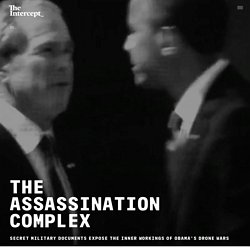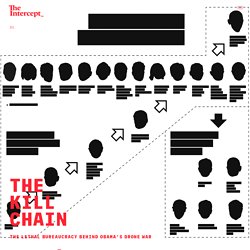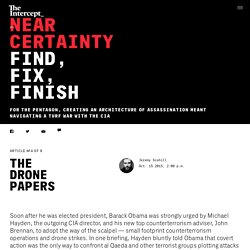

Les États-Unis existent-ils encore? Virer les responsables politiques. La “strategie” US en Syrie se desagrege. The Drone Papers. The Assassination Complex. DRONES ARE A TOOL, not a policy.

The policy is assassination. While every president since Gerald Ford has upheld an executive order banning assassinations by U.S. personnel, Congress has avoided legislating the issue or even defining the word “assassination.” This has allowed proponents of the drone wars to rebrand assassinations with more palatable characterizations, such as the term du jour, “targeted killings.” When the Obama administration has discussed drone strikes publicly, it has offered assurances that such operations are a more precise alternative to boots on the ground and are authorized only when an “imminent” threat is present and there is “near certainty” that the intended target will be eliminated. Those terms, however, appear to have been bluntly redefined to bear almost no resemblance to their commonly understood meanings.
A Visual Glossary. Click any arrow to enter a rabbit hole.

Each serves as a back door into one of our stories. Birds The first bomb dropped from an airplane exploded in an oasis outside Tripoli on November 1, 1911.¹ While flying over Ain Zara, Libya, Lieutenant Giulio Gavotti leaned out of his airplane, which looked like a dragonfly, and dropped a Haasen hand grenade. The Kill Chain. THE DOCUMENTS COME FROM a Pentagon study, circulated in early 2013, evaluating the intelligence and surveillance technology behind the military’s Joint Special Operations Command (JSOC) killing campaign in Yemen and Somalia in 2011 and 2012.

The study, carried out by the Pentagon’s Intelligence, Surveillance, and Reconnaissance Task Force, illuminates and in some cases contradicts the administration’s public description of a campaign directed at high-level terrorists who pose an imminent threat to the United States. It admits frankly that capturing terrorists is a rare occurrence and hints at the use of so-called signature strikes against unknown individuals exhibiting suspicious behavior. Find, Fix, Finish. THE VIEW AMONG Obama’s inner circle was that Iraq and Afghanistan had served as useful laboratories for such tactics, but deploying them outside conventional war zones meant different legal and diplomatic considerations would apply.

An all-star team of special operations commanders, war planners, and Pentagon officials pressed the new president to dramatically ramp up the shadow wars in Yemen and Somalia to fight the emerging threats in those countries. They called for sweeping away bureaucratic obstacles and streamlining lethal operations. In short, a new global architecture of assassination was called for, and that meant navigating an increasingly tense turf war between the CIA and the Pentagon over these activities. The CIA had long dominated the covert war in Pakistan, and in 2009 Obama expanded the agency’s drone resources there and in Afghanistan to regularly pound al Qaeda, the Pakistani Taliban, and other targets.
Manhunting in the Hindu Kush. INTELLIGENCE COMMUNITY DOCUMENTS obtained by The Intercept, detailing the purpose and achievements of the Haymaker campaign, indicate that the American forces involved in the operations had, at least on paper, all of the components they needed to succeed.

After more than a decade of war in Afghanistan, a robust network of intelligence sources — including informants on the ground — had been established in parts of the historically rebellious, geographically imposing provinces of Kunar and Nuristan. The operators leading the campaign included some of the most highly trained military units at the Obama administration’s disposal, and they were supported by the world’s most powerful electronic surveillance agencies, equipped with technology that allowed for unmatched tracking of wanted individuals. Despite all these advantages, the military’s own analysis demonstrates that the Haymaker campaign was in many respects a failure. Photo: U.S. Firing Blind. THOSE SHORTFALLS STEM from the remote geography of Yemen and Somalia and the limited American presence there.

As a result, the U.S. military has been overly reliant on signals intelligence from computers and cellphones, and the quality of those intercepts has been limited by constraints on surveillance flights in the region. The documents are part of a study by a Pentagon Task Force on Intelligence, Surveillance, and Reconnaissance. The Life and Death of Objective Peckham. A SMALL AND STOCKY British-Lebanese citizen with a head of thick dark hair, Berjawi had grown up much like any other young boy in the United Kingdom’s capital city, attending school during the day and playing soccer with friends in his free time.

But by his early 20s he was leading no ordinary life. He was suspected of having cultivated ties with senior al Qaeda militants in East Africa, his British citizenship was abruptly revoked, and he was placed on a U.S. kill list. Target Africa. ERADICATING BLANK SPACES on maps of the “dark continent” was an obsession of Western powers during the 19th-century scramble for Africa.

Today, a new scramble is underway to eradicate a different set of blank spots. The U.S. military has, since 9/11, engaged in a largely covert effort to extend its footprint across the continent with a network of mostly small and mostly low-profile camps. Operation Haymaker - The Intercept. Small Footprint Operations 5/13 - The Intercept. The Intercept. Geolocation Watchlist - The Intercept.